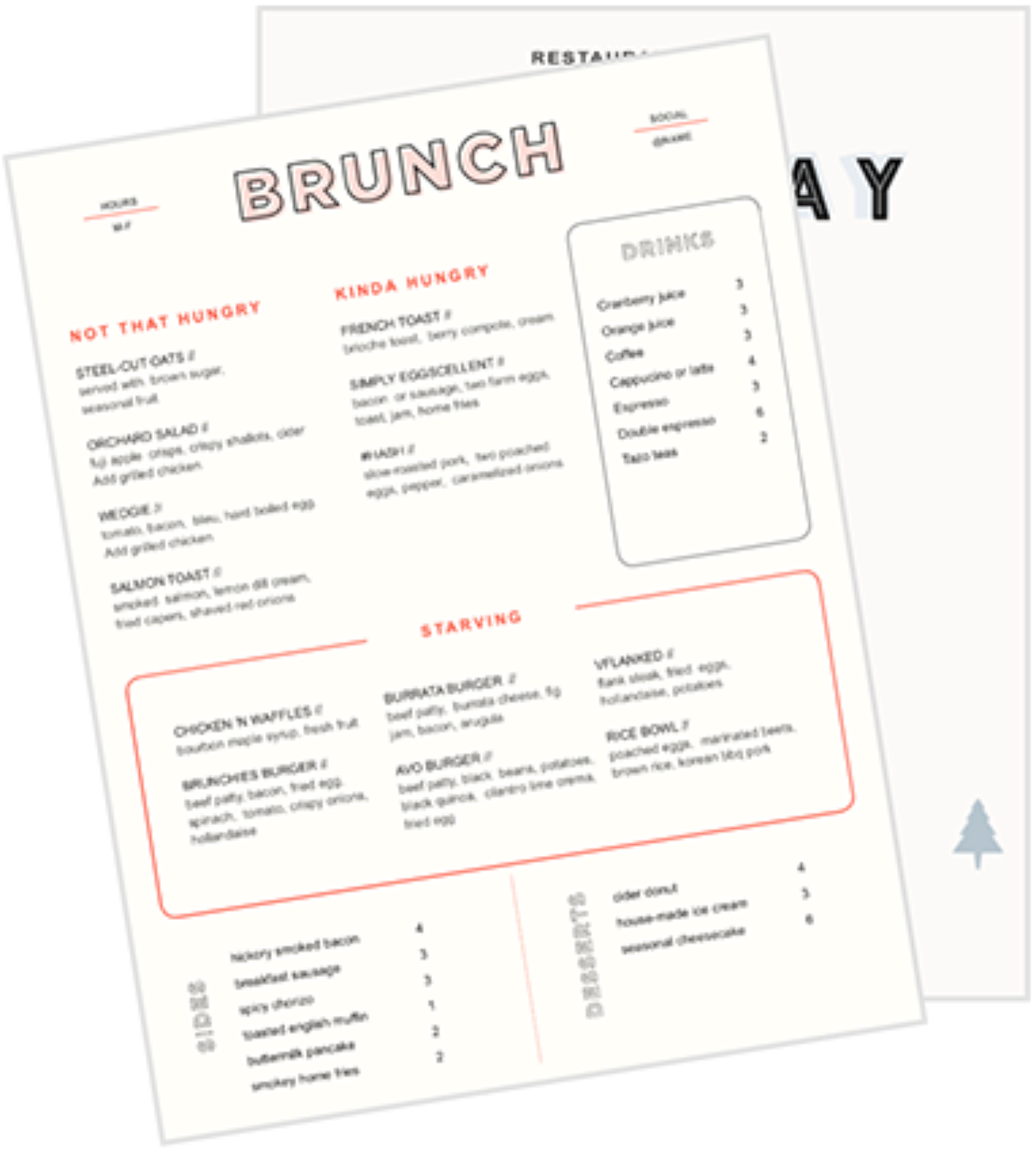
Menu Board Design: Elevating Your Restaurant's Visual Impact and Customer Experience
Creative menu board ideas to elevate your restaurant's visual appeal and drive sales.

Caroline PriceAuthor


Restaurant Menu Templates
Use these menu templates as a starting point for your menu design or to give your menus a refresh.
Get free downloadAs a restaurant owner, you understand the critical role your menu plays in the success of your business. However, it's not just what's on the menu, but how it's presented. An effective menu board design can significantly enhance your customer experience, streamline operations, and boost your bottom line.
In this comprehensive guide, we'll explore the art and science of restaurant menu design, providing actionable insights and creative menu board ideas to elevate your restaurant's visual appeal and drive sales.
The Importance of Effective Menu Board Design
Leading global restaurant consultant, Aaron Allen, emphasized, “The single most important piece of marketing collateral a restaurant operator wields is its menu. It’s so straight-forward (yet so easy to slip up on essential strategic-level concerns).”
Before diving into specific design strategies, let's consider why menu board design matters:
First Impressions: The restaurant menu board is one of the first things customers see, setting the tone for their dining experience.
Decision Influencer: A well-designed menu board can guide customers' attention toward high-margin menu items and increase overall sales.
Brand Reinforcement: Your signage should reflect your restaurant's personality and strengthen your brand identity.
Operational Efficiency: Clear, eye-catching menu signs can speed up the ordering process, reducing wait times and improving customer satisfaction.
Key Elements of Successful Menu Board Design
According to the National Restaurant Association, 9 in 10 adults say they enjoy going to restaurants to enjoy a favorite meal because they can’t easily duplicate the flavor and taste at home. Creating an effective menu design is crucial as it not only influences customer choices and satisfaction but also drives sales and encourages repeat visits. Consider these key elements when designing your menu board to effectively communicate with customers and enhance their dining experience:
Readability
The most crucial aspect of any menu board is its readability. Customers should be able to quickly and easily understand your offerings. Consider the following:
Font Choice: Use clear, legible fonts. Sans-serif fonts are often good choices due to their simplicity.
Font Size: Ensure the text is large enough to read from a distance. Make the main categories the largest, followed by item names, descriptions, and pricing.
Contrast: High contrast between text and background colors improves readability.
Spacing: Allow for adequate white space to prevent a cluttered appearance.
Organization
A well-organized menu board helps customers navigate offerings efficiently:
Logical Grouping: Arrange menu items into clear categories.
Visual Hierarchy: Use size, color, and positioning to highlight important information or specials.
Consistent Layout: Maintain a uniform structure across all sections for a cohesive look.
Color Scheme
Color choices can significantly impact the effectiveness of your menu board:
Brand Alignment: Use colors that complement your restaurant's interior design and branding.
Color Psychology: Leverage color psychology to influence mood and appetite.
Contrast: Ensure sufficient contrast between text and background for optimal readability.
Imagery
Strategic use of imagery can make your menu board more appealing and informative:
High-Quality Photos: When using images, ensure they are professional and appealing.
Icons: Simple icons can quickly convey information like dietary restrictions or spice levels.
Balance: Don't overcrowd your menu board with images. A few well-placed photos can be more effective than numerous small ones.
Price Presentation
How you display pricing can influence purchasing decisions:
De-emphasize Dollar Signs: Studies have shown that removing dollar signs can lead to higher spending.
Price Positioning: Place the price after the item description rather than in a separate column to keep focus on the dish itself.
Price Endings: Consider using .95 or .99 endings, which can make prices seem lower than rounded numbers.
Digital vs. Traditional Menu Boards
Menu boards can be displayed in a digital or traditional format. Each has advantages:
Digital Menu Boards:
Easy Updates: Change prices, add specials, or remove sold-out items in real time.
Dynamic Content: Showcase high-quality food images, videos, or multimedia content.
Dayparting: Automatically switch menus for different meal services.
Integration: Digital menu boards often integrate with digital signage software for seamless management.
Traditional Menu Boards:
Lower Initial Cost: Generally less expensive to implement than digital displays.
Reliable: No risk of technical glitches or power outages that can affect the display.
Authenticity: Can contribute to a more rustic or artisanal ambiance.
Tactile Experience: Physical boards can be more engaging for some customers.
Creative Menu Board Design Ideas
Creative menu board design captivates customers with engaging visuals, clear organization, and brand consistency to enhance the dining experience. Here are some different options:
Digital Menu Board Design
Leverage technology for dynamic displays:
Use digital menu board templates to create professional designs quickly.
Incorporate video content to showcase food preparation or highlight special offers.
Utilize TV screens to display your menu alongside engaging content.
Chalkboard Menu
Embrace the charm of handwritten chalkboards:
Hire a local artist to create beautiful, eye-catching designs.
Use high-quality chalkboard paint and good lighting for clarity.
Regularly update to convey a sense of freshness and seasonality.
Letter Board
Combine nostalgia with modern flair:
Use a mix of white and colored letters to highlight specific items.
Easily change messages or promote daily specials.
Consider a hanging menu board for a unique touch.
Custom Menu Boards
Create a unique design that perfectly fits your brand:
Work with a graphic designer to develop a custom menu board that aligns with your restaurant's aesthetic.
Use materials and design elements that complement your interior design.
Consider creating a mockup before finalizing your design to ensure it meets your expectations.
Digital Signage Software
Utilize specialized software for enhanced functionality:
Easily manage multiple digital displays from a central location.
Schedule content changes to align with different dayparts or special events.
Integrate with your POS system for real-time inventory updates.
Implementing Your Menu Board Design: Best Practices
As you develop your menu board design, keep these best practices in mind:
Know Your Audience: Tailor the design to your target demographic's preferences and needs.
Test and Iterate: Implement changes gradually and gather customer reviews to refine your approach.
Stay Consistent: Maintain brand consistency across all customer touchpoints, including your menu board and social media.
Highlight Profitability: Use design elements to draw attention to high-margin items or specials.
Update Regularly: Keep your menu board fresh by updating seasonal items or promoting limited-time offers.
Consider Lighting: Ensure your menu board is well-lit and readable in all lighting conditions.
Leverage Technology: Consider using tools like Canva to create professional-looking designs, even without extensive graphic design experience.
Measuring the Impact of Your Menu Board Design
After implementing your new menu board design, it's crucial to measure its impact:
Track changes in overall sales and average ticket size.
Monitor shifts in the popularity of specific menu items, especially those highlighted on the new board.
Gather customer feedback on the new design's clarity and appeal.
Analyze any changes in operational efficiency, such as reduced order errors.
Use these insights to continually refine your menu board strategy and maximize its effectiveness.
FAQ for Restaurant Owners
Frequently asked questions about creating menu boards:
1. How often should I update my menu board design?
Consider refreshing your design seasonally or whenever you make significant menu changes.
2. Can I create a professional menu board design without hiring a graphic designer?
Yes, tools like Canva offer menu board templates that can help you create professional-looking designs.
3. How do I choose between a digital menu board and a traditional one?
Consider factors like your budget, the frequency of menu changes, and your restaurant's overall aesthetic.
4. How can I make my specials stand out on the menu board?
Use contrasting colors, larger fonts, or dedicated sections to draw attention to your special offers.
5. Should I include prices on my menu board?
Generally, yes. Customers appreciate transparency, but consider de-emphasizing dollar signs to potentially increase spending.
Elevating Your Restaurant with Thoughtful Menu Board Design
Your menu board is more than just a list of offerings – it's a powerful tool for communication, brand reinforcement, and sales optimization. By implementing thoughtful, strategic menu board design, you can enhance your restaurant's atmosphere, streamline operations, and ultimately drive profitability.
Remember, the most successful menu boards strike a balance between aesthetics and functionality, ensuring that your culinary creations remain the stars of the show while guiding customers toward satisfying choices. Whether you opt for high-tech digital displays or artisanal chalkboard creations, the key is to choose a design that aligns with your brand, engages your customers, and effectively showcases your unique offerings.
As you embark on your menu board design journey, don't be afraid to experiment and iterate. Your perfect menu board solution might combine elements from several ideas or inspire you to create something unique. The goal is to develop a menu board that not only informs but also excites and delights your customers, setting the stage for an exceptional dining experience that keeps them coming back for more.
By investing time and thought into your menu board design, you're not just updating a functional element of your restaurant – you're crafting a key part of your customer's experience and your brand's story. So, take this opportunity to let your creativity shine and watch as your well-designed menu board becomes a cornerstone of your restaurant's success.
Is this article helpful?
DISCLAIMER: This information is provided for general informational purposes only, and publication does not constitute an endorsement. Toast does not warrant the accuracy or completeness of any information, text, graphics, links, or other items contained within this content. Toast does not guarantee you will achieve any specific results if you follow any advice herein. It may be advisable for you to consult with a professional such as a lawyer, accountant, or business advisor for advice specific to your situation.
Subscribe to On the Line
Sign up to get industry intel, advice, tools, and honest takes from real people tackling their restaurants’ greatest challenges.
